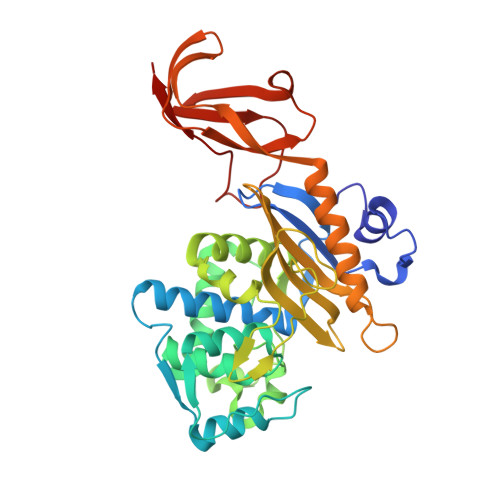Structural and kinetic analysis of penicillin-binding protein 4 (PBP4)-mediated antibiotic resistance inStaphylococcus aureus.
Alexander, J.A.N., Chatterjee, S.S., Hamilton, S.M., Eltis, L.D., Chambers, H.F., Strynadka, N.C.J.(2018) J Biological Chem
- PubMed: 30366985
- DOI: https://doi.org/10.1074/jbc.RA118.004952
- Primary Citation of Related Structures:
5TW4, 5TW8, 5TX9, 5TXI, 5TY2, 5TY7, 6C39, 6C3K - PubMed Abstract:
Methicillin-resistant Staphylococcus aureus (MRSA) causes serious community-acquired and nosocomial infections worldwide. MRSA strains are resistant to a variety of antibiotics, including the classic penicillin and cephalosporin classes of β-lactams, making them intractable to treatment. Although β-lactam resistance in MRSA has been ascribed to the acquisition and activity of penicillin-binding protein 2a (PBP2a, encoded by mecA ), it has recently been observed that resistance can also be mediated by penicillin-binding protein 4 (PBP4). Previously, we have shown that broad-spectrum β-lactam resistance can arise following serial passaging of a mecA -negative COL strain of S. aureus, creating the CRB strain. This strain has two missense mutations in pbp4 and a mutation in the pbp4 promoter, both of which play an instrumental role in β-lactam resistance. To better understand PBP4's role in resistance, here we have characterized its kinetics and structure with clinically relevant β-lactam antibiotics. We present the first crystallographic PBP4 structures of apo and acyl-enzyme intermediate forms complexed with three late-generation β-lactam antibiotics: ceftobiprole, ceftaroline, and nafcillin. In parallel, we characterized the structural and kinetic effects of the PBP4 mutations present in the CRB strain. Localized within the transpeptidase active-site cleft, the two substitutions appear to have different effects depending on the drug. With ceftobiprole, the missense mutations impaired the K m value 150-fold, decreasing the proportion of inhibited PBP4. However, ceftaroline resistance appeared to be mediated by other factors, possibly including mutation of the pbp4 promoter. Our findings provide evidence that S. aureus CRB has at least two PBP4-mediated resistance mechanisms.
- From the Department of Biochemistry and Molecular Biology.
Organizational Affiliation:




















